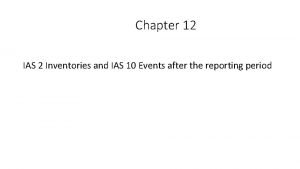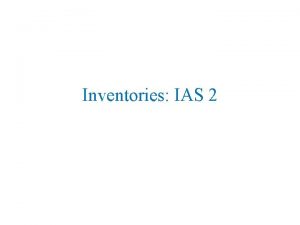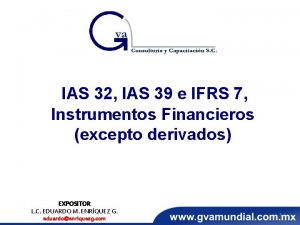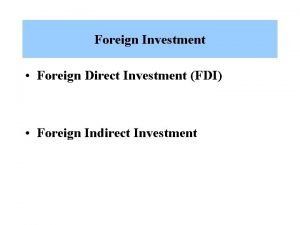IAS 21 The Effects of Changes in Foreign





































- Slides: 37

IAS 21 The Effects of Changes in Foreign Exchange Rates Prahallad Chandra Das FCMA Assistant Professor Dept. of Accounting & Information Systems Jatiya Kabi Kazi Nazrul Islam University Trishal, Mymensingh-2220 Connolly – International Financial Accounting and Reporting – 4 th Edition

Overview of IAS-21 • IAS 21 The Effects of Changes in Foreign Exchange Rates outlines how to account foreign currency transactions and operations in financial statements, and also how to translate financial statements into a presentation currency. An entity is required to determine a functional currency (for each of its operations if necessary) based on the primary economic environment in which it operates and generally records foreign currency transactions using the spot conversion rate to that functional currency on the date of the transaction. • IAS 21 was reissued in December 2003 and applies to annual periods beginning on or after 1 January 2005. Connolly – International Financial Accounting and Reporting – 4 th Edition

31. 1 INTRODUCTION • • • Exchange rates effect competitiveness • Businesses that deal in a foreign currency are exposed to risks • • IAS 21 The Effects of Changes in Foreign Exchange Rates A strong / weak currency impacts on exports and imports There is arguably no one best position – it depends on the nature of your business IAS 29 Financial Reporting in Hyperinflationary Economies Connolly – International Financial Accounting and Reporting – 4 th Edition

IAS 21 The Effects of Changes in Foreign Exchange Rates Objective and Scope • The objective of IAS 21 is to prescribe how to include foreign currency transactions and foreign operations in the financial statements of an entity and how to translate financial statements into a presentation currency. [IAS 21. 1] The principal issues are which exchange rate(s) to use and how to report the effects of changes in exchange rates in the financial statements. [IAS 21. 2] Connolly – International Financial Accounting and Reporting – 4 th Edition

Key definitions • Functional Currency The currency of the primary economic environment in which the enterprise operates. • Presentation Currency The currency in which an enterprise presents its financial statements. • Exchange Difference This is the difference resulting from translating one currency into another currency at different exchange rates. • Monetary and Non Monetary Items Monetary items are assets/liabilities held to be received/paid in fixed or determinable amounts. Examples include deferred tax, pensions and provisions. The feature of a non-monetary item is the absence of a right to receive a fixed or determinable amount of money (this includes prepayments, goodwill, intangible assets, inventory and property). Connolly – International Financial Accounting and Reporting – 4 th Edition

Key definitions • Closing Rate This is the spot exchange rate at the reporting date. • Spot Exchange Rate The exchange rate for immediate delivery. • Exchange Rate The ratio of exchange for two currencies. • Foreign operations a subsidiary, associate, joint venture, or branch whose activities are based in a country or currency other than that of the reporting entity. Connolly – International Financial Accounting and Reporting – 4 th Edition

Determining the functional currency • The functional currency is the currency of the primary economic environment in which the entity operates and it is normally the currency in which the entity primarily generates and expends cash. • IAS-21 provides primary and secondary indicators for use in the determination of an entity’s functional currency, as summarized below. • • Primary Indicators: The currency that mainly influences sales prices for goods and services(often the currency in which prices are denominated and settled). Connolly – International Financial Accounting and Reporting – 4 th Edition

Determining the functional currency • The currency of the country whose competitive forces and regulations mainly determine the sales prices of its goods and services; and • The currency that mainly influences labour, material and other costs of providing goods or services(often the currency in which prices are denominated and settled). • • Secondary Indicators: • The currency in which receipts from operating activities are usually retained. The currency in which funds from financing activities (raising loans and issuing equity) are generated; and Connolly – International Financial Accounting and Reporting – 4 th Edition

31. 2 Foreign Currency Transactions • Initial Recognition Ø Each transaction should be translated using the ER(Exchange rate) on the date the transaction occurred, or if stable, an average rate Ø If certain transactions are to be settled at a specified rate, or are covered by a matching forward contract, then the use ‘contracted rate’ • Subsequent measurement Ø A foreign currency transaction may give rise to assets or liabilities that are denominated in a foreign currency. These assets and liabilities will need to be translated into the entity’s functional currency at each reporting date. How they will be translated depends on whether the assets and liabilities are monetary or non-monetary items. Connolly – International Financial Accounting and Reporting – 4 th Edition

31. 2 Foreign Currency Transactions • Monetary items: The essential feature of a monetary item, as the definition implies, is the Ø Ø Ø Ø Ø Cash and bank balances right to receive(or an obligation to deliver) a fixed or determinable number of units of currency. Exemples: Trade receivables an payables Loan receivables an payables Foreign currency bonds held as available for sale Foreign currency bonds held to maturity Pensions and other employee benefits to be paid in cash Provisions that are to be settled in cash Cash dividends that are recognised as a liability A contract to receive (or deliver Connolly – International Financial Accounting and Reporting – 4 th Edition

31. 2 Foreign Currency Transactions • Non-Monetary items A Non-monetary item does not give the right to receive(or an obligation to deliver) a fixed or determinable number of units of currency. Exemples: Ø Amounts prepaid for goods and services Ø Goodwill Ø Intangible assets Ø PPE Ø Provisions to be settled by the delivery of a non- monetary asset Ø Equity instruments that are held as available for sale financial assets Ø Equity instruments in subsidiaries, associates or joint ventures Connolly – International Financial Accounting and Reporting – 4 th Edition

• Reporting at Subsequent Reporting Dates ØMonetary items at closing ER (e. g. trade receivables and payables) ØNon-monetary items measured at HC are not re- translated at the reporting date (e. g. non-current assets and inventory) ØNon-monetary items measured at foreign currency fair value are re-translated at each date of fair value measurement Connolly – International Financial Accounting and Reporting – 4 th Edition

Recognition of exchange differences • • Those arising on settlement of monetary items should be expensed in the period they arise Where a gain/loss on a non-monetary item is recognised directly in equity any exchange component of that gain/loss should be recognised directly in equity Conversely when a gain/loss on a non-monetary item is recognised in profit or loss, any exchange component of that gain/loss should be recognised in profit or loss. If a transaction is settled before the end of a reporting, then: (i) record the foreign currency transaction in the functional currency at the spot exchange rate at the date of the transaction (an average rate for a period may be used if exchange rates do not fluctuate significantly); (ii) record the settlement at the exchange rate at the date of settlement; (iii) recognise the exchange difference (i. e. (i) minus (ii) in arriving at operating profit in the statement of comprehensive income). Connolly – International Financial Accounting and Reporting – 4 th Edition

Example 31. 1: Transactions settled at the reporting date Blue Limited, whose year end is 31 December, buys goods from a foreign company for 180, 000 Ricos on 31 July 2013. The transaction is settled on 31 October 2013. Exchange rates: 31 July 2013 € 1 = 1. 5 Ricos 31 October 2013 € 1 = 1. 6 Ricos Requirement Show the journal entries to record the above transaction. Connolly – International Financial Accounting and Reporting – 4 th Edition

Example 31. 1: Transactions settled at the reporting date Initial recognition: Dr SPLOCI – P/L – purchases Cr SFP – trade payables € 120, 000 Being initial recognition of goods purchased on credit (180, 000 Ricos / 1. 5) At settlement: Dr SFP – trade Payables Cr SPLOCI – P/L – Fx Gain (e. g. Co. S) Cr SFP – Cash € 120, 000 € 7, 500 € 112, 500 Being settlement and recognition of exchange difference Connolly – International Financial Accounting and Reporting – 4 th Edition

Transactions not settled at the reporting date If a transaction is not settled before the end of a reporting, then: (i) record the transaction (in the functional currency) at the spot exchange rate at the date of the transaction; (ii) retranslate any monetary items; (iii) recognise any exchange difference in arriving at profit or loss in SPLOCI. Connolly – International Financial Accounting and Reporting – 4 th Edition

Example 31. 2: Transactions not settled at the reporting date Top Limited buys goods from a foreign company for 500, 000 Zicos on 31 October 2012. The transaction was not settled at 31 December 2012, the company’s year end. Exchange rates: 31 October 2012 € 1 = 1. 6 Zicos 31 December 2012 € 1 = 1. 75 Zicos Requirement Show the journal entries to record the above transaction. Connolly – International Financial Accounting and Reporting – 4 th Edition

Example 31. 2: Transactions not settled at the reporting date Initial recognition: Dr SPLOCI – P/L – purchases Cr SFP – trade payables € 312, 500 Being initial recognition of goods purchased on credit (500, 000 Zicos / 1. 6) At the reporting date: Dr SFP – trade payables Cr SPLOCI – P/L – Fx Gain € 26, 786 Being translation of payable at reporting date and recognition of exchange difference Connolly – International Financial Accounting and Reporting – 4 th Edition

Example 31. 3: Purchase of a non-monetary item A company purchased a property on 1 January 2013 for 20, 000 DM (when € 1 = 4 DM), with the account being settled on 1 March 2013 when the exchange rate was 20, 000 DM = € 5, 500. If the company’s year end is after 1 March 2013, then this transaction should be recorded as follows: At 1 January 2013: Dr SFP – property Cr SFP – payables € 5, 000 Being initial recognition of property At 1 March 2013: Dr SPLOCI – P/L – Fx Loss € 500 Dr SFP – payables € 5, 000 Cr Bank € 5, 500 Being settlement of liability and recognition of exchange difference Connolly – International Financial Accounting and Reporting – 4 th Edition

Example 31. 3: Purchase of a non-monetary item However, if the company’s year end is 31 January 2013, and at 31 January 2013 20, 000 DM = € 4, 900, then: At 31 January 2013: Dr SFP – payables Cr SPLOCI – P/L – exchange gain 31 March 2013: Dr SFP – payables Dr SPLOCI – P/L - exchange loss Cr SFP – bank € 100 € 4, 900 € 600 € 5, 500 Connolly – International Financial Accounting and Reporting – 4 th Edition

31. 3 FOREIGN CURRENCY TRANSLATION • • • Should follow normal consolidation procedures (See Chapters 26 -28). IAS 27 permits the use of different reporting dates as long as they are no more than three months apart and adjustments are made for the effects of any significant transactions between those dates. In such cases, the exchange rate to adopt is that at the reporting date of the foreign operation. IAS 21 shows how to translate FS into a presentation currency (i. e. the currency in which the FS are presented. This contrasts with the functional currency, which is the currency of the primary economic environment in which the (foreign) entity operates. Depending upon the relationship between the parent and the subsidiary companies, the presentation currency and the functional currency may or may not be the same. Connolly – International Financial Accounting and Reporting – 4 th Edition

Normal consolidation procedures • • • Eliminate IC balances Need to translate I/C monetary balances Goodwill treated as asset of foreign operation and translated at CR Connolly – International Financial Accounting and Reporting – 4 th Edition

Presentation currency = Functional currency SAME FUNCTIONAL CURRENCY: i. e. Foreign trade conducted as a direct extension of investing company Decision depends upon: • Extent to which foreign cash flows have a direct impact upon those of the investing company • Extent to which the functioning of the enterprise is dependent directly upon the investing company • Currency in which the majority of the trading transactions are denominated • Major currency to which the operation is exposed Specific circumstances: • Acts as a selling agent • Merely a producer/manufacturer • Located overseas for tax or exchange control reasons Connolly – International Financial Accounting and Reporting – 4 th Edition

Presentation currency = Functional currency The translation mechanics are: • Non-monetary assets (e. g. PPE and inventory) translated at historical rate (Cost or Revaluation) • Monetary assets and liabilities (e. g. receivables and payables) translated at CR • OSC (Opening Share Capital) and pre-acquisition reserves at historic rate (i. e. ‘acquisition rate’) • Post-acquisition reserves are a balancing figure • SPLOCI translated using ER ruling at the dates the amounts recorded in the financial statements were established (e. g. Depreciation - Historic Rate) All other items - Average Rate • If available, use rates specific to opening and closing inventory • Exchange difference included in PBT in the SPLOCI – P/L Connolly – International Financial Accounting and Reporting – 4 th Edition

Presentation currency ≠ Functional currency Indicators are: • Investment based on net worth of foreign entity • May be partly financed by local currency loans • Day-to-day operations of foreign entity are not dependent on holding company’s currency • Net investment will remain until business is liquidated or disposed Connolly – International Financial Accounting and Reporting – 4 th Edition

Presentation currency ≠ Functional currency The translation mechanics are: • Assets & liabilities translated at the year-end rate (i. e. CR) • OSC and pre-acquisition reserves at historic rate (i. e. ‘acquisition rate’) • Post-acquisition reserves are a balancing figure • Compare difference between closing reserves and opening reserves with translated retained earnings to obtain exchange difference • Exchange differences taken directly to reserves (separate component) • SPLOCI translated using AR • Exchange difference will arise from: Ø Retranslating the opening NA at CR Ø Translating SPLOCI at AR and SFP at CR Connolly – International Financial Accounting and Reporting – 4 th Edition

Foreign exchange differences Presentation Currency = Functional Currency: • Exchange differences should be recognised in the SPLOCI – P/L. Presentation Currency ≠ Functional Currency (Presentation Currency Method): • All exchange differences should be recognised in equity as a separate component (through OCI). • Foreign exchange differences arise from: 1. Translating income and expenses at the transaction rate and assets/liabilities at the CR; 2. Translating opening net assets at an exchange rate different from that previously reported; 3. As any goodwill and fair value adjustments should be treated as assets and liabilities of the foreign operation, they therefore must be expressed in the functional currency of the foreign operation and translated at the CR. If a foreign operation is not 100% owned by the parent company, then exchange differences should be allocated to NCI. Connolly – International Financial Accounting and Reporting – 4 th Edition

Disposal of foreign entity Cumulative exchange differences should be recognised as income or expenses in the same period as the gain or loss on disposal is recognised Connolly – International Financial Accounting and Reporting – 4 th Edition

Disclosure 1. The amount of exchange differences included in arriving at profit or loss in the SPLOCI except those arising from IAS 39; 2. Net exchange differences classified as a component of equity and a reconciliation of opening and closing equity at start and end of the year; 3. When the presentation currency is different from the functional currency, that fact should be disclosed as well as disclosure of the functional currency and the reason for using a different presentation currency; 4. When there is a change in the functional currency of either the reporting entity or a significant foreign operation, that fact and reason for the change should be disclosed; 5. When an entity presents its financial statements in a currency different from its functional currency, it should describe the statements as complying with IFRSs only if they comply with all of the requirements of each applicable standard and SIC. Where the requirements listed at item 5. above are not met an entity should: • clearly identify the information as supplementary; • disclose the currency in which the supplementary information is displayed; • disclose the entity’s functional currency and method of translation used to determine the supplementary information. Connolly – International Financial Accounting and Reporting – 4 th Edition

Example 31. 4: Translation of a foreign subsidiary

FUNCTIONAL CURRENCY # PRESENTATION CURRENCY Quickbuck Limited 1. SPLOCI TRANSLATED USING AR Revenue Cost of sales $ ER € 544, 275 4 136, 069 (145, 000) 4 (36, 250) Gross profit 399, 275 Depreciation (30, 000) 4 (7, 500) (271, 050) 4 (67, 762) Other expenses PBT 99, 819 98, 225 Income tax expense PAT (24, 275) 24, 557 4 73, 950 OCI: FX losses (6, 069) 18, 488 (W 5(b)) (3, 198) 15, 290 Connolly – International Financial Accounting and Reporting – 4 th Edition

2. A & L TRANSLATED USING CR 3. OSC TRANSLATED USING HR 4. RE AS BALANCING FIGURE PPE $ ER € 270, 000 5 54, 000 Inventory 48, 525 5 9, 705 Receivables 45, 500 5 9, 100 9, 475 5 1, 895 Bank and cash 373, 500 74, 700 Ordinary share capital 75, 000 3 25, 000 RE & FC translation reserve (should be shown separately) 70, 450 Balance (W 6) 4, 090 Loan 90, 000 5 18, 000 Payables 103, 775 5 20, 755 Taxation 24, 275 5 4, 855 Proposed dividends 10, 000 5 2, 000 373, 500 Connolly – International Financial Accounting and Reporting – 4 th Edition 74, 700

5. CALCULATE FX DIFFERENCE $ ER € (a) Opening NA at OR [Prior year CR] Ordinary share capital [No change] 75, 000 3 25, 000 Retained earnings [$70, 450 - $53, 950] 16, 500 (Balance) 5, 500 91, 500 3 30, 500 91, 500 5 18, 300 Opening NA at CR 12, 200 (b) Translate RE [SPLOCI at AR v SFP at CR) PAT [See SPLOCI] 73, 950 4 18, 488 Dividends paid [Per Q] (10, 000) 4 (2, 500) Dividends proposed (10, 000) 5 (2, 000) RE per SPLOCI [mainly at AR] 53, 950 RE per SFP [at CR] 53, 950 Taken through OCI [W 1 € 18, 488 - € 3, 198 = € 15, 290] (c) TOTAL FX LOSS (Separate component of equity) Connolly – International Financial Accounting and Reporting – 4 th Edition 13, 988 5 (10, 790) 3, 198 15, 398

6. MOVEMENT ON RETAINED EARNINGS € Opening RE at 1 January 2012 (See w 5 a) 5, 500 Retained profit for year (See w 5 b) 13, 988 19, 488 FX loss (to be presented separately) (See w 5 c) (15, 398) Closing RE at 31 December 2012 (See w 4) 4, 090 Connolly – International Financial Accounting and Reporting – 4 th Edition

FUNCTIONAL CURRENCY = PRESENTATION CURRENCY Quickbuck Limited 1. TRANSLATE SFP Non monetary at HR Monetary A&L at CR $ ER € 270, 000 2. 5 108, 000 Inventory 48, 525 4. 8 10, 109 Receivables 45, 500 5 9, 100 9, 475 5 1, 895 PPE Bank and cash 373, 500 129, 104 Ordinary share capital 75, 000 3 25, 000 Retained earnings 70, 450 (Balance) 58, 494 Loan 90, 000 5 18, 000 Payables 103, 775 5 20, 755 Taxation 24, 275 5 4, 855 Proposed dividends 10, 000 5 2, 000 373, 500 Connolly – International Financial Accounting and Reporting – 4 th Edition 129, 104

FUNCTIONAL CURRENCY = PRESENTATION CURRENCY 2. SPLOCI TRANSLATED USING ER RULING AT DATES AMOUNTS RECORDED IN FS $ ER € Revenue 544, 275 4 136, 069 Opening inventory Purchases Closing inventory Cost of sales 41, 000 152, 525 (48, 525) 145, 000 3 4 4. 8 13, 667 38, 131 (10, 109) 41, 689 Gross profit 399, 275 Depreciation (30, 000) 2. 5 (12, 000) (271, 050) 4 (67, 762) Other expenses FX gain - PBT (W 3(b)) 98, 225 Income tax expense PAT 94, 380 (24, 275) 73, 950 Connolly – International Financial Accounting and Reporting – 4 th Edition 28, 945 43, 563 4 (6, 069) 37, 494

3. CALCULATE EXCHANGE DIFFERENCE $ ER € Ordinary share capital 75, 000 3 25, 000 Retained earnings [$70, 450 - $53, 950] 16, 500 (Balance) 25, 500 (a) Translate opening SFP 91, 500 PPE Inventory Net monetary liabilities (to balance) 50, 500 300, 000 2. 5 120, 000 41, 000 3 13, 667 (249, 500) 3 (83, 167) 91, 500 50, 500 (b) Opening RE (see above) + profit for year (PAT € 8, 549 – divs. Paid € 2, 500 – divs. Prop € 2, 000) Closing RE per SFP FX gain (include in SPLOCI – P/L) Connolly – International Financial Accounting and Reporting – 4 th Edition 25, 500 4, 049 (58, 494) 28, 945
 Too foreign for home
Too foreign for home Changes in latitudes, changes in attitudes meaning
Changes in latitudes, changes in attitudes meaning What's a physical change
What's a physical change Sơ đồ cơ thể người
Sơ đồ cơ thể người Công thức tính độ biến thiên đông lượng
Công thức tính độ biến thiên đông lượng Số nguyên là gì
Số nguyên là gì Tỉ lệ cơ thể trẻ em
Tỉ lệ cơ thể trẻ em đặc điểm cơ thể của người tối cổ
đặc điểm cơ thể của người tối cổ Các châu lục và đại dương trên thế giới
Các châu lục và đại dương trên thế giới ưu thế lai là gì
ưu thế lai là gì Thẻ vin
Thẻ vin Các môn thể thao bắt đầu bằng tiếng chạy
Các môn thể thao bắt đầu bằng tiếng chạy Tư thế ngồi viết
Tư thế ngồi viết Cái miệng nó xinh thế chỉ nói điều hay thôi
Cái miệng nó xinh thế chỉ nói điều hay thôi Hình ảnh bộ gõ cơ thể búng tay
Hình ảnh bộ gõ cơ thể búng tay Mật thư anh em như thể tay chân
Mật thư anh em như thể tay chân Từ ngữ thể hiện lòng nhân hậu
Từ ngữ thể hiện lòng nhân hậu Trời xanh đây là của chúng ta thể thơ
Trời xanh đây là của chúng ta thể thơ Tư thế ngồi viết
Tư thế ngồi viết Giọng cùng tên là
Giọng cùng tên là Gấu đi như thế nào
Gấu đi như thế nào Thơ thất ngôn tứ tuyệt đường luật
Thơ thất ngôn tứ tuyệt đường luật Sự nuôi và dạy con của hươu
Sự nuôi và dạy con của hươu Diễn thế sinh thái là
Diễn thế sinh thái là Thế nào là hệ số cao nhất
Thế nào là hệ số cao nhất Vẽ hình chiếu vuông góc của vật thể sau
Vẽ hình chiếu vuông góc của vật thể sau Ng-html
Ng-html Phép trừ bù
Phép trừ bù Thế nào là mạng điện lắp đặt kiểu nổi
Thế nào là mạng điện lắp đặt kiểu nổi Lời thề hippocrates
Lời thề hippocrates Vẽ hình chiếu đứng bằng cạnh của vật thể
Vẽ hình chiếu đứng bằng cạnh của vật thể Glasgow thang điểm
Glasgow thang điểm đại từ thay thế
đại từ thay thế Quá trình desamine hóa có thể tạo ra
Quá trình desamine hóa có thể tạo ra Khi nào hổ con có thể sống độc lập
Khi nào hổ con có thể sống độc lập Các châu lục và đại dương trên thế giới
Các châu lục và đại dương trên thế giới Dot
Dot Bổ thể
Bổ thể





























































